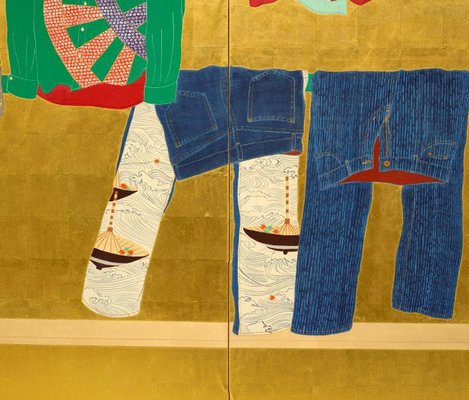
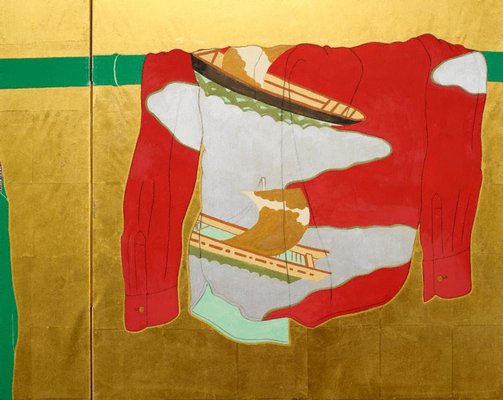
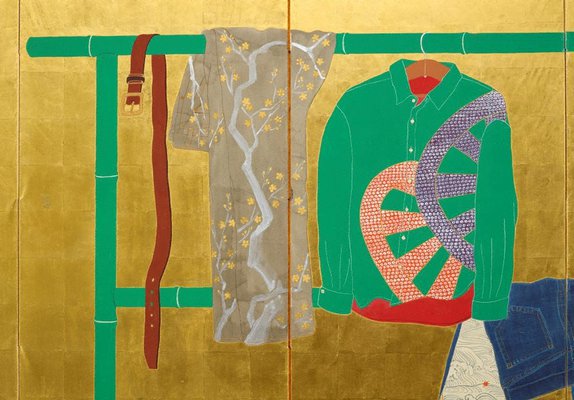
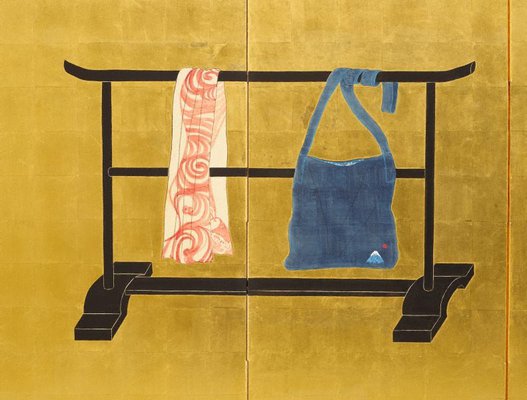
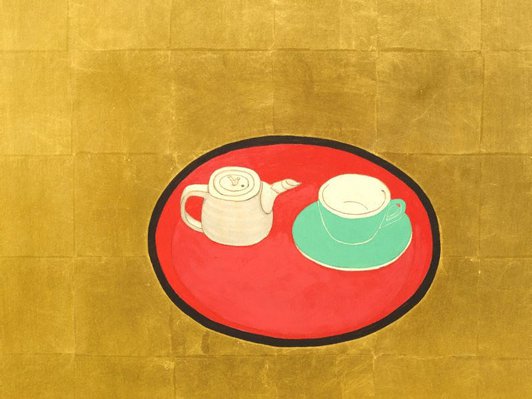
-
Details
- Place where the work was made
-
Japan
- Date
- 2005
- Media categories
- Screen , Painting
- Materials used
- six-panel screen; Japanese mineral pigments on paper with gold leaf
- Dimensions
- 166.0 x 366.0 cm
- Credit
- Purchased with funds provided by the Asian Art Collection Benefactors 2011
- Location
- Not on display
- Accession number
- 81.2011
- Copyright
- © Taro Yamamoto. Image courtesy of imura art gallery, Japan
- Artist information
-
Yamamoto Tarō
Works in the collection
- Share
-
-
About
A graduate of the renowned Kyoto University of Arts and Design (Kyoto Zokei Geijutsu Daigaku), Yamamoto has gained acknowledgements for his witty, imaginative approach to Japanese paintings since the beginning of the 21st century. Especially his reputation and market value have risen remarkably after he has won the prestigious VOCA (‘Vision of Contemporary Art’) prize in 2007. Similar to the Tokyo-based artists Akira Yamaguchi, Tenmyouya Hisashi – and to a certain extend the internationally more well-known Takashi Murakami and Yoshitomo Nara – who consciously refers to traditional Japanese painting techniques and motifs to underline their national identity in the increasing globalized art world, Yamamoto uses traditional painting materials, formats and iconography to portray contemporary Japanese society and culture. Acknowledging the fact that local traditions and imported consumerism are inseparable in contemporary Japan, Yamamoto declares his painting style as ‘Nippon-ga’, which – to use his words – ‘restructures traditional 'nihonga' from a modern point of view’.
The six-fold screen ‘Whose clothes?’, a work from Yamamoto’s early creative period, exemplifies idiosyncratic approach. Seemingly floating on the blank background covered in gold leaves are two clothing racks – the taller one made of green bamboo and the smaller one lacquered in black – bearing three pairs of trousers, bright coloured shirts with daring patterns, a leather belt, an indigo-dyed hand bag with long shoulder straps and a 'tenugui', the multi-functional cotton cloth often used by Japanese men. A lacquer tray with a Chinese style tea pot and a Western set of tea cup and saucer is placed in between them. With the strong contrast between the flatly applied, opaque pigments and the brilliant gold ground, the abstract quality of the composition and the exoticism of the textile decorations, this highly decorative six-fold screen exerts an immediate appeal on the audience.
However, there are more layers in Yamamoto’s work than a superficial visual attraction. Viewers familiar with traditional Japanese art will recognize numerous painting techniques and motifs prevalent in the Edo period (1603-1868) such as the 'tarashikomi' (one colour/ink applied on another layer of half-dried colour to create effect of shadow) technique as seen in the grey trousers, the decorative water-swirls on the 'tenugui', the water wheels, the leisure boats partly covered by bands of cloud and the open umbrellas floating on waves. Moreover, they will also connect this contemporary art work to a type of screen popular in genre painting of the late 16th century. Featuring elegant short-sleeve kimonos ('kosode') casually draped over lacquered wooden racks and other objects closely connected with a beautiful, sophisticated woman such as music instruments, purses or amulets, these screens were generally called 'Tagasode', or ‘Whose sleeves?’.
First appearing in a classical poem from the 10th century poetry anthology “Collected Japanese poems of ancient and modern times” ('Shin Kokin Wakashū')[1], the term 'tagasode' has since gained the meaning of the yearning for an absent lover, while the elegant kimono sleeves on the clothing racks and the fragrance arising from the garments conjure up her image. Beside this romantic connotation, the sumptuously decorated garments also had more practical functions, namely to display the wealth and sophistication of the owners as well as the contemporary fashion.
Hence, Yamamoto’s screen can be seen as an appropriation, a parody of a classical painting theme. The garments on the racks conjure up the image of a young man and the tea tray hints at his hobby. The types of clothing displayed on the racks testify the dramatic change in Japanese fashion since the Edo period. Jeans, shirts and leather belts reflect the Westernization, or to be more precise, ‘Americanization’, that Japanese culture has undergone since the opening of the country in 1868 and more drastically since the end of World War II.
[1] The 10th century poem from the 'Shin Kokin Wakashū' reads: ‘The fragrance seems even more alluring than the hue, Whose sleeves have brushed past? Or would it be this plum tree blossoming here at home?’ ('Iro yori mo/ ka koso aware to / omohoyure/ tagasode fureshi / yado no ume zo mo').
Asian Art Department, AGNSW, February 2011.
-
Places
Where the work was made
Japan
-
Exhibition history
Shown in 8 exhibitions
Who's clothes?, Gallery Iteza, Kyoto, , 2005 -
NIPPONGA BYOBU MATSURI, Gallery Iteza, Kyoto, , 2006 -
ART CHAOS 2006, Spiral Garden, Tokyo, , 2006 -
ART CHAOS 2006, Galerie Aube, Kyoto, , 2006 -
TASOGARE-NIPPON, Motoazabu Gallery, Toyama, , 2007 -
TASOGARE-NIPPON, Silver wave, Kanazawa Ishikawa, , 2007 -
Taro Yamamoto Exhibition - Nippon-Ga new but classical Japanese art, Museum Eki, Kyoto, , 2009 -
Taro Yamamoto, NIPPONGA, Shiinoki Geihinkan, Kanazawa, , 2010 -
Kamisaka Sekka - Dawn of modern Japanese design, Art Gallery of New South Wales, Sydney, 21 Jun 2012–26 Aug 2012
Conversations through the Asian collections, Art Gallery of New South Wales, Sydney, 25 Oct 2014–13 Mar 2016
-
Bibliography
Referenced in 2 publications
-
Khanh Trinh (Editor), Kamisaka Sekka: dawn of modern Japanese design, Sydney, 2012, 163 (colour illus.). cat.no. 84
-
Yamamoto Tarō, Nippon-Ga – new but classical Japanese art, Japan, 2009, 48-49.
-

